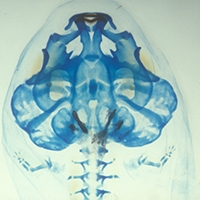Citation:
| 1.17 MB |
Date Published:
AprAbstract:
The primitive, or ancestral reproductive mode for Recent amphibians involves a complex, biphasic life history, Yet evolutionarily derived, alternate modes are seen in all three living orders and predominate in some clades, Analysis of the consequences and mechanistic bases of one such mode-direct development-can provide insights into the evolutionary opportunities and constraints conferred by the ancestral metamorphic ontogeny, Direct development in the anuran genus Eleutherodactylus involves fundamental alterations to many features of embryonic and posthatching development, At hatching, young emerge as fully formed, albeit tiny versions of the adult; most larval features are absent, Pervasive changes in ontogenetic timing, in particular the precocious (embryonic) formation of many adult structures, appear to be correlated with early development of the thyroid axis, although responsiveness to exogenous thyroid hormone is diminished or even lacking in at least some peripheral tissues, Changes in cranial patterning are likely mediated by the embryonic neural crest, although many gross features of crest biology are highly conserved, Laboratory-based analyses of direct development and other derived reproductive modes in amphibians, using contemporary methods developed for more standard, ''model'' organisms, may contribute important insights into life-history evolution that complement those derived from analyses of morphology, ecology and phylogeny.
Notes:
Wy611Times Cited:44Cited References Count:77






